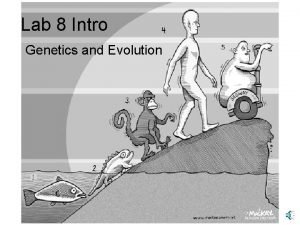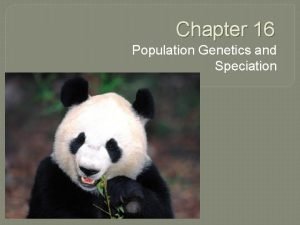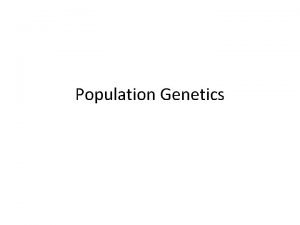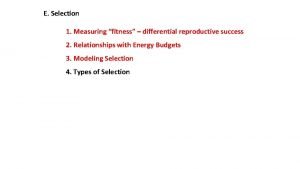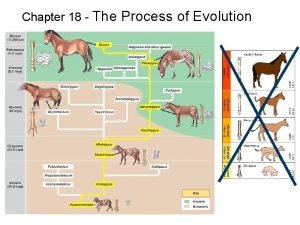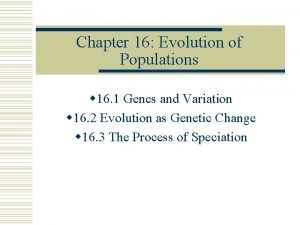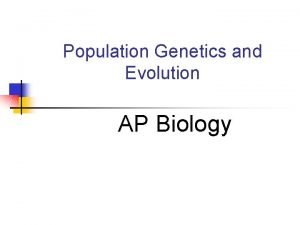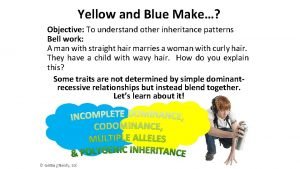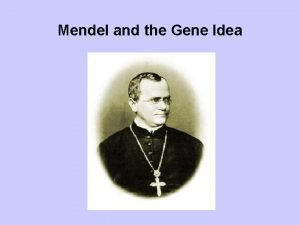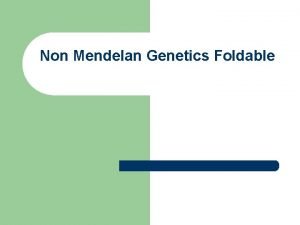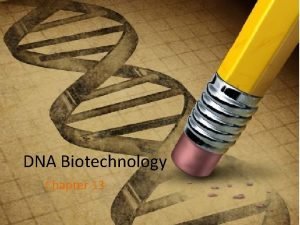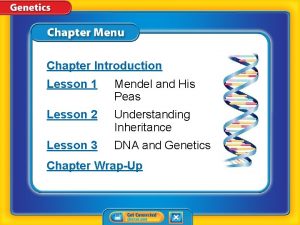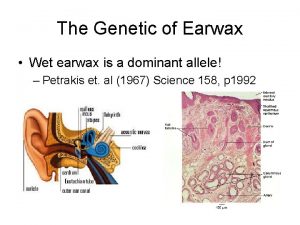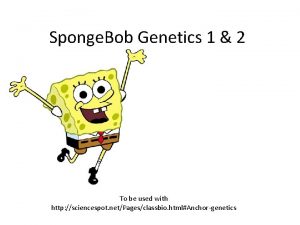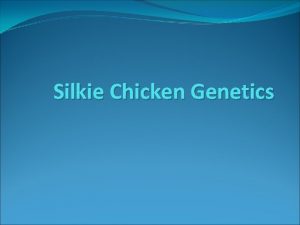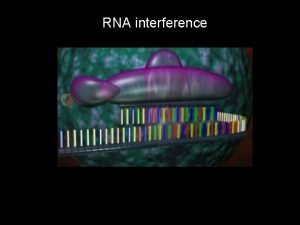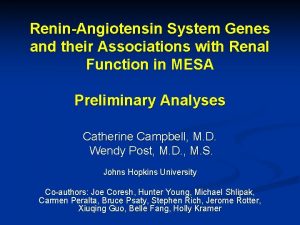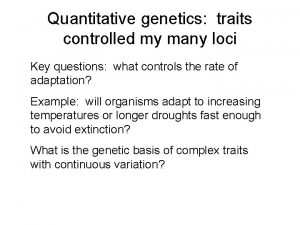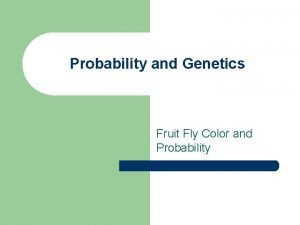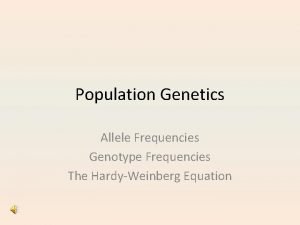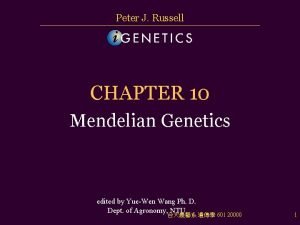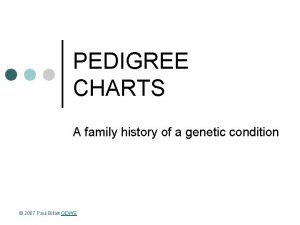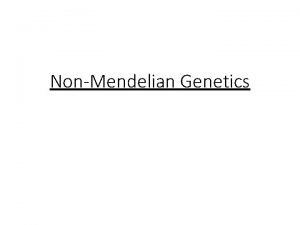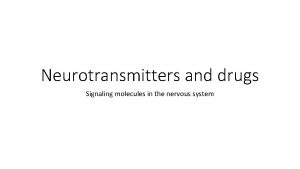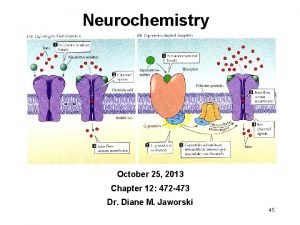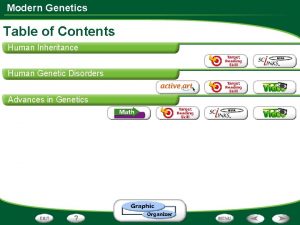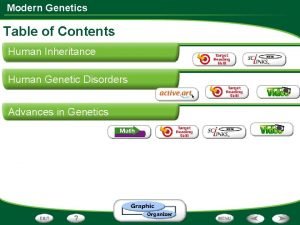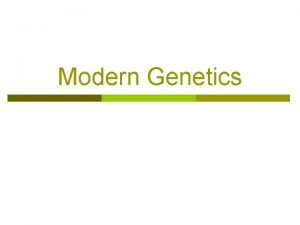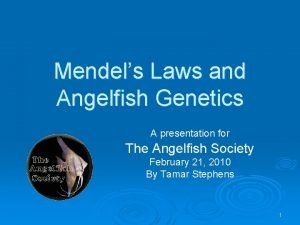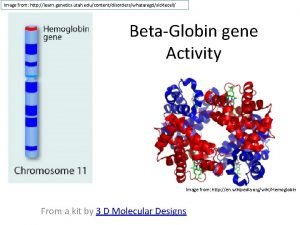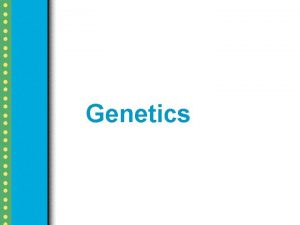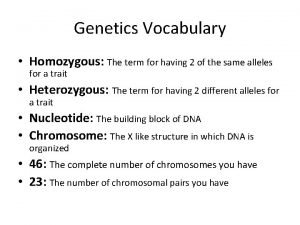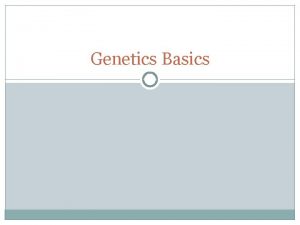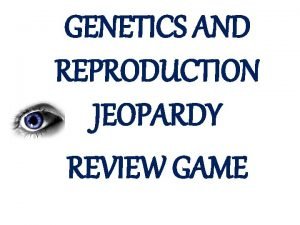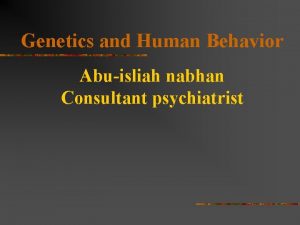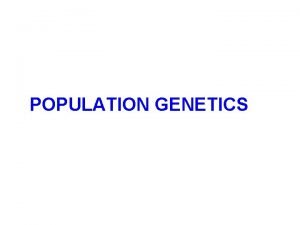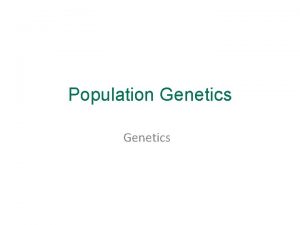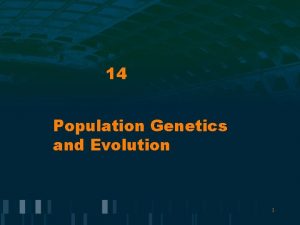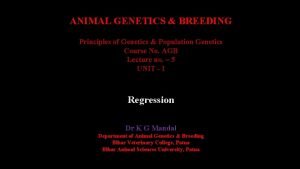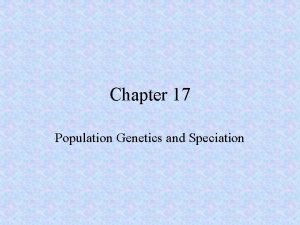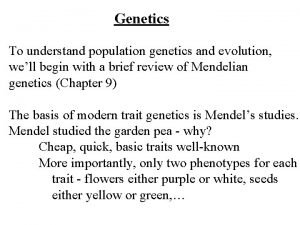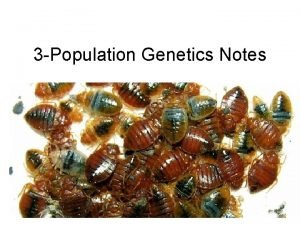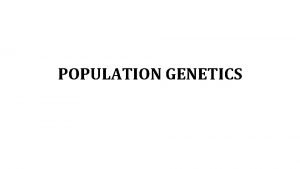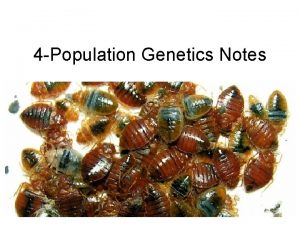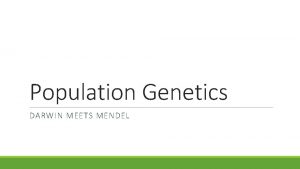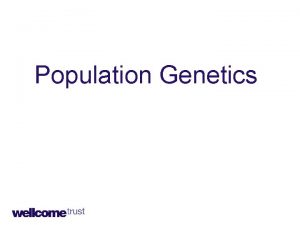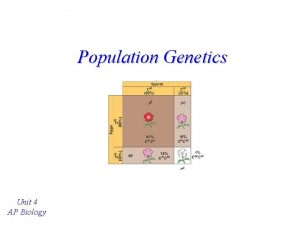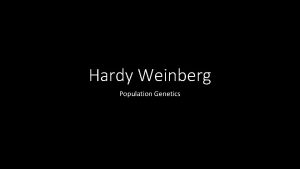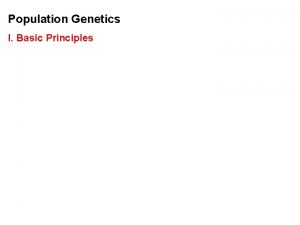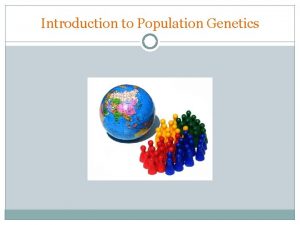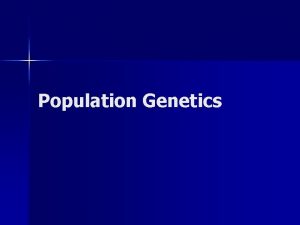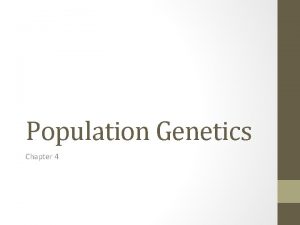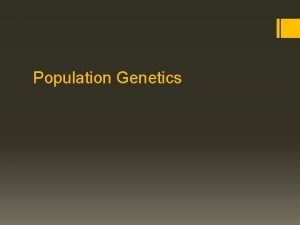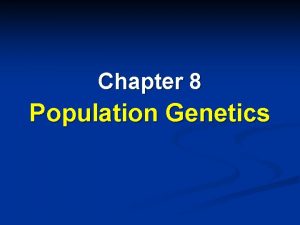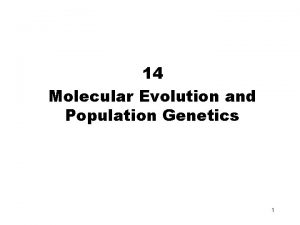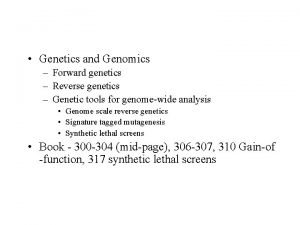Population genetics and evolution What is evolution Population























































- Slides: 55

Population genetics and evolution • What is evolution?

Population genetics and evolution • What is evolution? – Descent with modification

Population genetics and evolution • What is evolution? – Descent with modification – A change in the characteristics of a population over time

Population genetics and evolution • What is evolution? – Descent with modification – A change in the characteristics of a population over time – A change in the genetic composition of a population over time (the frequency of genes)

Population genetics and evolution • Some genetics terminology – Chromosomes…

Population genetics and evolution human karyotype fig here

Population genetics and evolution • Some genetics terminology – Chromosomes… – Homologous chromosomes…

Population genetics and evolution human karyotype fig here

Population genetics and evolution • Some genetics terminology – Chromosomes… – Homologous chromosomes… – Locus…

Population genetics and evolution • Some genetics terminology – Chromosomes… – Homologous chromosomes… – Locus… – Alleles…

Population genetics and evolution • Alleles… • • • Hemoglobin has two A chains and two B chains The B chains have several forms… fetal adult normal adult “sickle” These are a result of “alleles” - different forms of the same gene at the same locus

Population genetics and evolution • Some genetics terminology – Alleles may be dominant and recessive

Population genetics and evolution • Some genetics terminology – Alleles may be dominant and recessive – In Biston betularia, the gene for melanism is dominant (M)

Population genetics and evolution • Some genetics terminology – Alleles may be dominant and recessive – In Biston betularia, the gene for melanism is dominant (M) – The gene for typical color is recessive (m)

Population genetics and evolution • Some genetics terminology – Alleles may be dominant and recessive – In Biston betularia, the gene for melanism is dominant (M) – The gene for typical color is recessive (m) – Each individual moth has two alleles: – MM and Mm are melanic, mm are typical

Population genetics and evolution • Gene frequencies – The frequency of all of the alleles at a particular locus in a population = 100% or 1. 0

Population genetics and evolution • Gene frequencies – The frequency of all of the alleles at a particular locus in a population = 100% or 1. 0 – If there are two alleles, the frequency of one = p and the frequency of the other = q

Population genetics and evolution • Gene frequencies – The frequency of all of the alleles at a particular locus in a population = 100% or 1. 0 – If there are two alleles, the frequency of one = p and the frequency of the other = q – p + q = 1. 0

Population genetics and evolution • Gene frequencies – The frequency of all of the alleles at a particular locus in a population = 100% or 1. 0 – If there are two alleles, the frequency of one = p and the frequency of the other = q – p + q = 1. 0 – Each individual has two alleles, one from each parent – With sexual reproduction, p + q alleles in the eggs are combined with p + q alleles in the sperm

Population genetics and evolution • Gene frequencies (p + q) x (p + q) = (p + q)2 = p 2 + 2 pq + q 2

Population genetics and evolution • Gene frequencies – (p + q) x (p + q) = (p + q)2 = p 2 + 2 pq + q 2 – In Biston betularia: – MM occurs with a frequency of p 2 – Mm occurs with a frequency of 2 pq – mm occurs with a frequency of q 2

Population genetics and evolution • Gene frequencies – (p + q) x (p + q) = (p + q)2 = p 2 + 2 pq + q 2 – In Biston betularia: – The population is composed of p 2 homozygous melanic individuals, 2 pq heterozygous individuals (which are melanic), and q 2 homozygous typical individuals

Population genetics and evolution • Gene frequencies – (p + q) x (p + q) = (p + q)2 = p 2 + 2 pq + q 2 – In Biston betularia: – Phenotype frequencies: – Let’s say for argument’s sake that the population consists of 81% typical individuals and 19% melanic individuals…

Population genetics and evolution • Gene frequencies – p 2 = MM, 2 pq = 2 Mm, and q 2 = mm – q 2 =. 81 – what is q, the frequency of m?

Population genetics and evolution • Gene frequencies – p 2 = MM, 2 pq = 2 Mm, and q 2 = mm – q 2 =. 81 – what is q, the frequency of m? – q = 0. 9 (0. 92 = 0. 81)

Population genetics and evolution • Gene frequencies – p 2 = MM, 2 pq = 2 Mm, and q 2 = mm – q 2 =. 81 – what is q, the frequency of m? – q = 0. 9 (0. 92 = 0. 81) – What is p, the frequency of M?

Population genetics and evolution • Gene frequencies – p 2 = MM, 2 pq = 2 Mm, and q 2 = mm – q 2 =. 81 – what is q, the frequency of m? – q = 0. 9 (0. 92 = 0. 81) – What is p, the frequency of M? – p = 0. 1

Population genetics and evolution • Gene frequencies – p 2 = MM, 2 pq = 2 Mm, and q 2 = mm – q 2 =. 81 – what is q, the frequency of m? – q = 0. 9 (0. 92 = 0. 81) – What is p, the frequency of M? – p = 0. 1 – p 2 = 0. 01 (MM), 2 pq = 0. 18 (Mm)

Population genetics and evolution • Gene frequencies – p 2 = MM, 2 pq = 2 Mm, and q 2 = mm – q 2 =. 81 – what is q, the frequency of m? – q = 0. 9 (0. 92 = 0. 81) – What is p, the frequency of M? – p = 0. 1 – p 2 = 0. 01 (MM), 2 pq = 0. 18 (Mm) – 19% of individuals are melanic

Population genetics and evolution • To summarize: – Homozygous dominants = MM = p 2 – Heterozygotes = Mm = 2 pq – Homozygous recessives = mm = q 2

Population genetics and evolution • What happens during reproduction? – Meiosis separates alleles into gametes

Population genetics and evolution • What happens during reproduction? – Meiosis separates alleles into gametes – Gametes bear alleles in proportion to their frequency in the population…

Population genetics and evolution • What happens during reproduction? – Meiosis separates alleles into gametes – Gametes bear alleles in proportion to their frequency in the population… – there are p sperm with M and q sperm with m

Population genetics and evolution • What happens during reproduction? – Meiosis separates alleles into gametes – Gametes bear alleles in proportion to their frequency in the population… – there are p sperm with M and q sperm with m – there are p eggs with M and q eggs with m

Population genetics and evolution • What happens during reproduction? – Meiosis separates alleles into gametes – Gametes bear alleles in proportion to their frequency in the population… – there are p sperm with M and q sperm with m – there are p eggs with M and q eggs with m – Eggs and sperm combine to form zygotes…

Population genetics and evolution • What happens during reproduction? EGGS SPERM M (p = 0. 1) m (q = 0. 9) M (p = 0. 1) MM (p 2 = 0. 01) Mm (pq = 0. 09) m (q = 0. 9) Mm (pq = 0. 09) mm (q 2 = 0. 81)

Population genetics and evolution • After reproduction: – Homozygous dominants = MM = p 2 = 0. 01 – Heterozygotes = Mm = 2 pq = 0. 18 – Homozygous recessives = mm = q 2 = 0. 81 – Melanics = 0. 19 (0. 01 + 0. 18) – Typicals = 0. 81

Population genetics and evolution • After reproduction: – Homozygous dominants = MM = p 2 = 0. 01 – Heterozygotes = Mm = 2 pq = 0. 18 – Homozygous recessives = mm = q 2 = 0. 81 – Melanics = 0. 19 (0. 01 + 0. 18) – Typicals = 0. 81 – THIS IS WHAT WE STARTED WITH!!

Population genetics and evolution • What is evolution? A change in gene frequency within a population

Population genetics and evolution • What is evolution? A change in gene frequency within a population • What processes lead to changes in gene frequency?

Population genetics and evolution • processes that lead to changes in gene frequency:

Population genetics and evolution • processes that lead to changes in gene frequency: – Mutation (the ultimate source of all genetic variation)

Population genetics and evolution • processes that lead to changes in gene frequency: – Mutation – Gene flow (usually accomplished by migration of individuals from one population to another)

Population genetics and evolution

Population genetics and evolution • processes that lead to changes in gene frequency: – Mutation – Gene flow – Non-random mating

Population genetics and evolution • processes that lead to changes in gene frequency: – Mutation – Gene flow – Non-random mating – Selection (the most powerful agent of evolutionary change)

Population genetics and evolution • processes that lead to changes in gene frequency: – Mutation – Gene flow – Non-random mating – Selection – Genetic drift (changes in gene frequency in small populations due to random sampling error)

Population genetics and evolution • Genetic drift: – Changes in gene frequency in small populations due to random sampling error Brown (br) = 30% Yellow (y) = 20% Red (r) = 20% Orange (o) = 10% Green (g) = 10% Blue (bl) = 10%

Population genetics and evolution • Genetic drift: – Population bottlenecks - reduction of population size results in loss of genetic variation and potentially in the loss of alleles from the population – Reduction of population size must be catastrophic and non-selective

Population genetics and evolution • Genetic drift: Population bottlenecks

Population genetics and evolution • Genetic drift: Population bottlenecks

Population genetics and evolution • Genetic drift: Population bottlenecks

Population genetics and evolution • Genetic drift: Population bottlenecks

Population genetics and evolution • Genetic drift: – The Founder Effect - a small population disperses from a larger population, and founds a new population in another geographic location. The gene frequencies in the founding population are not representative of the larger population. – Especially important in speciation on archipelagoes

Population genetics and evolution Elepaio Amakihi
 Lab 8 population genetics and evolution
Lab 8 population genetics and evolution Population genetics and speciation worksheet answer key
Population genetics and speciation worksheet answer key What is fst
What is fst Modern synthesis
Modern synthesis The far side comics
The far side comics Population genetics
Population genetics Genetics
Genetics Population ecology section 1 population dynamics answer key
Population ecology section 1 population dynamics answer key Population ecology section 1 population dynamics answer key
Population ecology section 1 population dynamics answer key Population ecology section 1 population dynamics
Population ecology section 1 population dynamics Study guide chapter 4 section 1 population dynamics
Study guide chapter 4 section 1 population dynamics Andalusian chicken incomplete dominance
Andalusian chicken incomplete dominance Section 1 meiosis
Section 1 meiosis Pedigree miscarriage symbol
Pedigree miscarriage symbol Multiplication and addition rule genetics
Multiplication and addition rule genetics Human genetics concepts and applications 10th edition
Human genetics concepts and applications 10th edition Genetics is the study of heredity
Genetics is the study of heredity Chapter 22 genetics and genetically linked diseases
Chapter 22 genetics and genetically linked diseases Sexual reproduction and genetics section 1 meiosis
Sexual reproduction and genetics section 1 meiosis Genetics foldable
Genetics foldable Chapter 10 sexual reproduction and genetics
Chapter 10 sexual reproduction and genetics Molecular genetics and biotechnology
Molecular genetics and biotechnology Genetics and biotechnology chapter 13
Genetics and biotechnology chapter 13 Mendel and his peas lesson 1
Mendel and his peas lesson 1 Chapter 17 the beginning of the life cycle
Chapter 17 the beginning of the life cycle Earwax type genetics
Earwax type genetics Sponge billy bob
Sponge billy bob Silkie colors
Silkie colors Forward genetics
Forward genetics Genetics model
Genetics model Phenotypic variance
Phenotypic variance Probability in genetics
Probability in genetics Learn.genetics.utah/content/addiction/mouse
Learn.genetics.utah/content/addiction/mouse Genotype vs allele frequency
Genotype vs allele frequency Dihybrid cross branch diagram
Dihybrid cross branch diagram Pedigree key
Pedigree key Codominance
Codominance Http://learn.genetics.utah.edu/content/addiction/
Http://learn.genetics.utah.edu/content/addiction/ Adrenaline in the brain
Adrenaline in the brain Blood type genetics
Blood type genetics Human inheritance modern genetics answer key
Human inheritance modern genetics answer key Human clone
Human clone Modern genetics human inheritance answer key
Modern genetics human inheritance answer key Angelfish genetics
Angelfish genetics Pp x pp
Pp x pp Section 11-5 linkage and gene maps answer key
Section 11-5 linkage and gene maps answer key Http://learn.genetics.utah.edu
Http://learn.genetics.utah.edu Section 14-3 human molecular genetics answers
Section 14-3 human molecular genetics answers Genetics vocabulary review answer key
Genetics vocabulary review answer key Genetic vocabulary
Genetic vocabulary Clinodactyly
Clinodactyly Branch diagram genetics
Branch diagram genetics Introduction to mendelian genetics
Introduction to mendelian genetics Genetics jeopardy review game
Genetics jeopardy review game Tongue rolling genetics
Tongue rolling genetics Behavioral genetics consultant
Behavioral genetics consultant
